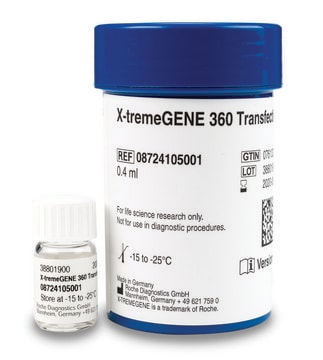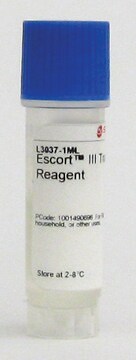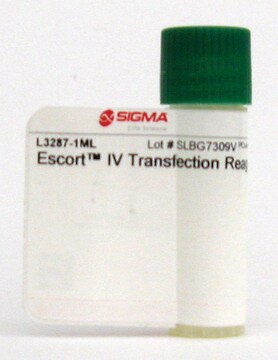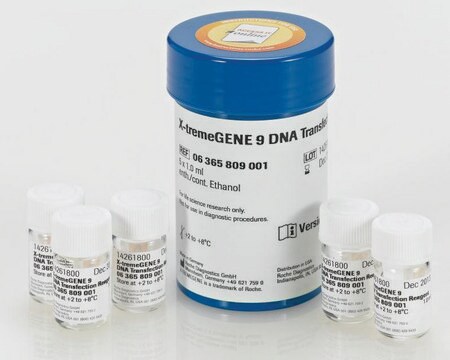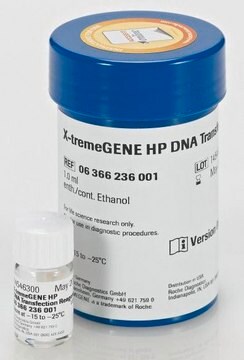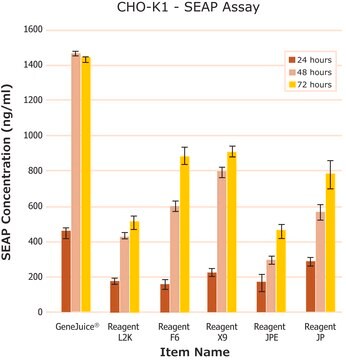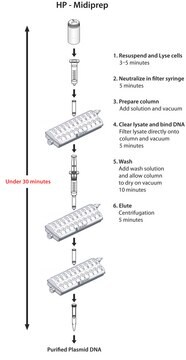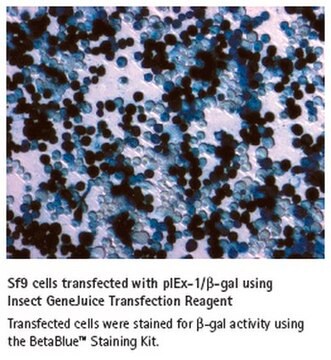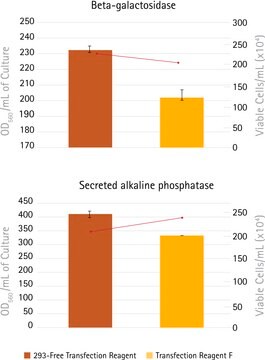T0956
Sigma Universal Transfection Reagent
Polymer reagent for transfecting common mammalian cell lines
Iniciar sesiónpara Ver la Fijación de precios por contrato y de la organización
About This Item
UNSPSC Code:
12352202
Productos recomendados
grade
for molecular biology
Quality Level
sterility
aseptically filled
form
liquid (buffered aqueous solution)
usage
sufficient for 110 transfections (3.5 cm dish)
sufficient for 40 transfections (10 cm dish)
sufficient for 65 transfections (6 cm dish)
concentration
2 mg/mL
storage temp.
−20°C
General description
Sigma Universal Transfection Reagent is a unique formulation of a biodegradable, proprietary cationic polymer conjugated to a cationic lipid. Universal Transfection Reagent is used for transfection of nucleic acids into common eukaryotic cell lines. Fast and easy protocol is compatible with serum, serum-free medium and antibiotics. For most cells, medium change after transfection is not necessary.
Application
Suitable for transient and stable transfection of nucleic acids into cultured eukaryotic cells. Use approximately 1-3 μl Universal Transfection Reagent per μg DNA. Protocol optimization provides very efficient transfection. The following cells have been successfully transfected using Sigma Universal Transfection Reagent:
Excellent for:
BHK-21
CHO
CHOK1
HEK293
HeLa
NIH3T3
Good for:
3LL
6CSFME
ATT20B16-F0
B16-F10
BAEC
Ca Ski
COS-7
CV-1
D 407
HUVEC
L929
MCF-7
MDCK
Neuro2A
SAOS-2
SHEP
SiHa
SKOV3
Excellent for:
BHK-21
CHO
CHOK1
HEK293
HeLa
NIH3T3
Good for:
3LL
6CSFME
ATT20B16-F0
B16-F10
BAEC
Ca Ski
COS-7
CV-1
D 407
HUVEC
L929
MCF-7
MDCK
Neuro2A
SAOS-2
SHEP
SiHa
SKOV3
Features and Benefits
- Fast, easy protocol
- Suitable for stable and transient transfection
- High efficiency for a wide variety of cell types including primary cells
- Compatible with both serum and serum-free transfection protocols
Components
Note the formulation of Sigma Universal Transfection Reagent is confidential.
Principle
Sigma Universal Transfection Reagent is a cationic polymer conjugated to a cationic lipid. When mixed with plasmid DNA, the reagent forms stable complexes that can be directly added to the cell culture. The cells take up the complexes by endocytosis, the polymer is cleaved from the complex, and the plasmid DNA is quickly released into the cytoplasm.
Other Notes
Complex formation is inhibited by serum, but once stable complexes have formed, the presence of serum lowers the toxicity of transfection.
related product
Referencia del producto
Descripción
Precios
Storage Class
12 - Non Combustible Liquids
wgk_germany
WGK 1
flash_point_f
Not applicable
flash_point_c
Not applicable
Elija entre una de las versiones más recientes:
¿Ya tiene este producto?
Encuentre la documentación para los productos que ha comprado recientemente en la Biblioteca de documentos.
Los clientes también vieron
Pan Pan et al.
Nature communications, 12(1), 4664-4664 (2021-08-04)
Excessive inflammatory responses induced upon SARS-CoV-2 infection are associated with severe symptoms of COVID-19. Inflammasomes activated in response to SARS-CoV-2 infection are also associated with COVID-19 severity. Here, we show a distinct mechanism by which SARS-CoV-2 N protein promotes NLRP3
Nuestro equipo de científicos tiene experiencia en todas las áreas de investigación: Ciencias de la vida, Ciencia de los materiales, Síntesis química, Cromatografía, Analítica y muchas otras.
Póngase en contacto con el Servicio técnico